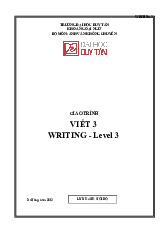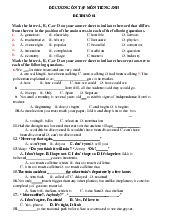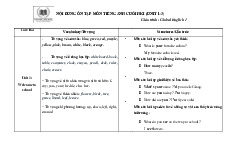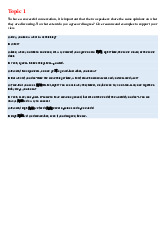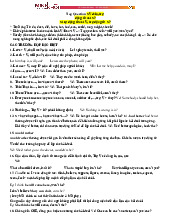












Preview text:
lOMoAR cPSD| 48302938
b. Kiến thức
- Có kiến thức cơ bản và tối thiểu về tiếng Anh bao gồm về ngữ âm, trọng âm, từ vựng, ngữ pháp.
- Mở rộng vốn từ vưng và trau dồi ngữ pháp cơ bản.
- Có thể hiểu sử dụng cấu trúc quen thuộc thường nhật; các từ ngữ cơ bản đáp ứng
nhu cầu giao tiếp cụ thể. c. kỹ năng
- Bốn kỹ năng nghe, nói, đọc, viết được trau dồi, trong đó nhấn mạnh hai ký năng nghe và đọc.
- Nắm được chiến lược, mẹo làm bài cho mỗi phần cụ thể
- Hiểu được những cụm từ, câu vắn ngắn với các hiện tượng ngữ pháp đã tiếp
xúc, có thể vận dụng cơ bản trong nói và viết. 2 . Kế hoạch giảng dạy
a. Tài liệu giảng dạy
450 start TOEIC ( tác giả: Anne Taylor & Casey Malarcher; NXB: Nhà xuất bản
thành phố Hồ Chí Minh. 2017) b. Phân phối chương trình
ST Nội dung Chi tiết Số T tiế t Grammar 1. Unit 1:
- Auxiliary + present or past participle (- ing, -ed) 02
Auxiliary Verbs Auxiliary verbs followed by a verb anding in – ing or – ed
Example: The oy is flying akite
The book was listed asabest seller
- Auxiliary + basic form of verb
Auxiliary verbs followed by the basic form of verb:
Modal auxiliaries, do in question / negative
sentences, or emphatic do + infinitive
Example : Paul may arrive tomorrow I do believe tha he is right 2. Unit 1:
- Meanings of modal auxiliary verbs 02
Auxiliary Verbs Will: be willing to, intend to
Shall: intend to (formal), have decided to May/Can: be possible to do
Can/Could/May: be allowed to do
Must: be necessary; be required to do lOMoAR cPSD| 48302938
Should/Ought to/ had better: be obliged to do 3.
Unit 2: Tenses - Differences between present tenses 02
Use present simple for routines, habits, or things
that new always true( ex: every time, every day…)
Use present progressive (is/are –ing) for a
temporary routine or situation, (now, today, at the moment ..)
Use present perfect( have/has –ed) for a situation
where things that happened in the past have a
result in the present ( just, yet, for, since, ever
never, first time this week..) 4.
Unit 2: Tenses - Differences between past tenses 02
Use past simple for something that was finished in the past
Use pas progressive ( was/were –ing) for a
temporary routine or situation in the past Use
past perfect (had –ed) for somethings that
happened before a certain point in the past. 5.
Unit 2: Tenses - Usage of WILL 02
Use WILL for instant decisions
Example: OK. I will accept your offer - Usage of BE GOING TO
Use BE GOING TO for established plans
Example: They are going to buy drinks for the party
- Present simple in adverbial clauses Use present
simple instead of future tense in adverbial clauses led by if, the moment, when, .. 6.
Unit 3: - Common verbs followed by a TO-INFINITIVE 02 Infinitives and
Agree, decide, expect, happen, pretend, promise,
Gerunds manage, tend… advise, aloow, expect, want, force, tell
- Common verbs followed by an INFINITIVE
Have, let, make, feel, see, hear, smell, find,…
- Common verbs followed by a GERUND Use an –ing
form after the following verbs: avoid, can’t help,
deny, feel like, give up, imagine, mind, postpone, enjoy lOMoAR cPSD| 48302938 7.
Unit 3: - Remember, forget, stop, try, regret + TO- 02
Infinitives and INFINITIVE or GERUND Gerunds
The choice of a to- infinitive or an –ing form depends on the meaning
Example: I forgot to turn the light off = I didn’t
turn it off. I forgot to do it.
I forgot turning the light off = actually turned it
off. I forgot that I had done that.
- The form of pronouns used with an INFINITIVE or GERUND 8.
Unit 4: - Participle adjectives ending in – ING used with 02 Participles
and agents participle If the participle of a noun is the agent( doing Clauses
action of the participle) choose an –ing form -
Participle adjectives ending in –ED used with nouns other than agents
If the participle is NOT the agents, Choose an – ed form 9. Unit 4:
- The correct use of a participle in participle 02 Participles and clauses
participle An –ing form can be used when two thong occur
Clauses at the same time
Example: He suddenly went out shouting
An –ing clause can be an explanation of the following main clauses
Example: felling tired, he went to bed earlier 10.
Unit 5: - Negation of non-finite verbs 02 Negation and
Put a negative word before non- finite verbs
Parallel - Redundancy in negation
Structure Avoid double negatives
Example: she does not have any money Do
not use a negative word along with such
words as hardly, seldom, scarcely, less, unless)
- Parallelism between words and phrases 12. Unit 6:
- Correct form of short and long comparatives 02 Comparisons
When comparing things, short adjectives ( one or two
syllables) end in –er/est Example: dark – darker – darkest Hot –Hotter – hottest Happy –happier –happiest lOMoAR cPSD| 48302938
For long adjectives ( three or more syllables)
used in comparisons, place more, most, less or least before the adjective.
Example: beautiful- more beautiful – most beautiful 13.
Unit 6: - Correct form of irregular comparatives 02 Comparisons
A few adjectives and adverbs have comparative
and superlative forms that are different from their regular forms: Example: He is as old as me.
- Modification of comparatives and superlatives
Words: Much, very much, far, a little, abit, a lot, any, no even, still
- Choosing between comparatives and superlatives
14 Unit 7 : - Subject –verb agreement after expressions of 02 Agreement
time, distance, price, and weight
Modifiers do not affect th number of the verbs
Expressions of time, distance, price and weight need a singular verb.
- Subject – verb agreement after expression of
time, distance price, and weight
In case of fractions of their equivalents, the noun
in the of – phrase determines the number of the verb.
The number of the verb is determined by what is
next to it in sentences with either A or B or neither A nor B 15. Unit 7 :
- Subject –verb agreement when the subject 02 Agreement
involves fractions or their equivalents
-Number agreement in A as well as B, not online
A but also B, (n)ether A (n)or B - Pronoun agreement in number
- Adjective/determiner –Noun Agreement
Modifiers and nouns modified by them agree in number
Example: this/ that book, these/ those books, every girl, all girls ..
Pronouns including reflexives must agree with their antecedent in number lOMoAR cPSD| 48302938 16.
Unit 8: Relative WHO is used when the antecedent in a person, Clauses
while WHICH issued when th antecedent is not a - Choosing WHO
person. However, THAT as a relative pronoun
WHICH or THAT 02 can replace either WHO or WHICH, and it
preferred especially after all, everything, nothing, the only, .. and superlative - Reviewing WHO,WHICH,THAT
- Using WHOSE to show possession
Possessive can be expressed by WHOSE whether
or not the antecedent is a person. When the
antecedent is not a person, of which .. may also be used 17.
Unit 8: Relative - Using WHAT as a relative pronoun 02 Clauses
The relative pronoun WHAT is different from the
other relative pronouns in that it is not preceded by a noun.
- Relative adverbs and their antecedents The
day/month/ year/time,.. +when:
Example: I remember the day when we meet
The hotel/park/place,.. + in which or wher The way + how The reason + why 18.
Unit 9: - Correct form of modifiers 02 Modification
Adverbs modify adjectives, adverbs, and verbs
and Word Adjectives modify nouns Order - Word order between ENOUGH and ADJECTIVES/ADVERBS
Example: he is old enough to see that movie -
Word order between words ending ir, -THING and adjectives
Words ending in –thing, -body – one – where
come before their adjectival modifiers 19.
Unit 9: - Word order in indirect questions 02 Modification
Questions involve inversion between subject and
and Word verb, but indirect questions involve no such lOMoAR cPSD| 48302938 Order inversion.
Example: I asked him how long he had been in America.
When the sentence begins with a negative word,
the subject comes after an auxiliary verb. 20.
Unit 10: - Differences and correct usage of BOTH, 02
Indefinite EITHER, and NEITHER Pronouns
Both: means “ two ( things/people)” and is often
followed by of + plural noun or and Either:
Means “ one or the orther of the two (
things/people)” and is followed by of plural noun or “ or”
Neither: Means “ not either one of the two
( things/people)” and is followed by of plural noun or nor
- Choosing between SOME or ANY Some: used in
affirmative answer is expected.
Any: Used in questions or in negative sentences. 21.
Unit 10: - Distinction of ANOTHER from THE OTHER 02
Indefinite One/the other: Used when there are two Pronouns things/people,..
One/another , the other; Used when there are three things/ people,..
- Distinction of MOST OF from MOST
Use ost of to talk about particular things or
people, and use most to talk about things or people in general. 22.
Unit 11: Voice - Appropriate form if verbs in passive sentences 02
Active: Subject + verb + object
- Verbs which may not be used as passive forms
Verbs like make, tell and ask are followed by a to-
infinitive in passive sentences 23. Unit 11: Voice
- Causative/perceptual verbs in passive sentences 02
Perceptual verbs like see, observe, and hear are followed either a to –
infinitive in passive sentences. lOMoAR cPSD| 48302938
- Prepositions in passive sentences
Complex verbs that consist of verb + preposition
are treated as one init when changed to passive 24. Unit 12:
- Choice of coordinate conjunctions 02 Conjunctions For –Because and Yet/But = However Prepositions Nor =and not So = Therefore
- Choice of subordinate conjunctions
Simultaneous action: when before, after, until
Reason: since, because, now that, seeing that
Ondition: if, unless, provided, as long as, once
Concession: even if, even though, although, though 25.
Unit 12: - Distinction between conjunctions and 02 Conjunctions
prepositions and Conjunctions are followed by subject + verb, Prepositions
while prepositons are followed by noun or an – ing form - Choice of prepositions For vs during By vs Until Between va among 26.
Review 1, 2 Grammar, Vocabulary 02 Test 1, 2
Listening & Reading Practice 27.
Unit 1: Part I: For each question in this part, you must 02
Grammar select the one statement that best describes what Focus: you see in the picture.
Auxiliary Verbs Part II: Listen to the question and choose the best answer
Part III: Short conversations : Choose the best answer to each question
Part IV: Short Talks : Choose the best answer to each questions. Unit 1:
Part V: Incomplete Sentences: Choose the word 02 lOMoAR cPSD| 48302938 28.
Grammar or phrase that best completes the sentence. Focus: Part VI: Incomplete Texts
Auxiliary Verbs Part VII: Reading comprehension 29.
Unit 2: Part I: For each question in this part, you must 02
Grammar select the one statement that best describes what Focus: Tenses
you see in the picture
Part II: Listen to the questions and choose the best answer
Part III: Short Conversations: Choose the best answer to each question
Part IV: Short Talks : Choose the best answer to each question 30.
Unit 2: Part V: Incomplete Sentences: Choose the word 02
Grammar or phrase that best completes the sentence Focus: Tenses
Part VI: Incomplete Texts
Part VII: Reading Comprehension 31.
Unit 3: Part I: For each question in this part, you must 02
Grammar select the one statement that best describes what Focus: you see in the picture Infinitives and
Part II: Listen to the questions and choose the Gerunds best answer
Part III: Short Conversations: Choose the best answer to each question
Part IV: Short Talks: Choose the best answer to each questions. 32.
Unit 3: Part V: incomplete Sentences: Choose the word 02 Grammar
or phrase that best completes the sentence Focus: Part VI: incomplete Texts Infinitives and
Part VII: Reading Comprehension Gerunds 33.
Unit 4: Part I: For each question in this part, you must 02
Grammar select the one statement that best describes what Focus you see in the picture.
Participles and Part II: Listen to the questions and choose the lOMoAR cPSD| 48302938
Participle best answer Causes
Part III: Short Conversations: Choose the best answer to each question
Part IV: Short Talks: Choose the best answer to each questions.
34. Unit 4: Part V: Incomplete Sentences: Choose the word 02
Grammar or phrase that best completes the sentence Focus Part VI: Incomplete Texts
Participles and Part VII: Reading Comprehension Participle Causes 35. Unit 5:
Part I: For each question in this part, you must 02
Grammar select the one statement that best describes what Focus:
Negation you see in the picture. and Parallel
Part II: Listen to the question and choose the best
Structure answer
Part III: Short conversations: Choose the best answer to each question
Part IV: Short talks: Choose the best answer to each question 36.
Unit 5: Part V: Incomplete sentences: Choose the word 02
Grammar or phrase that best completes the sentence
Focus: Negation Part VI: Incomplete Texts and Parallel
Part VII: Reading Comprehension Structure 37.
Unit 6: Part I: For each question in this part, you must 02
Grammar select the one statement that best describes what Focus: you see in the picture Comparisons
Part II: Listen to the question and choose the best answer
Part III: Short conversations :Choose the best answer to each question
Part IV: Short talks: Choose the best answer to each question lOMoAR cPSD| 48302938 38.
Unit 6: Part V: Incomplete sentences: Choose the word 02 Grammar
or phrase that best completes the sentence Focus: Part VI: Incomplete Texts Comparisons
Part VII: Reading Comprehension 39.
Unit 7: Part I: For each question in this part, you must 02
Grammar select the one statement that best describes what Focus: you see in the picture Agreement
Part II: Listen to the question and choose the best answer
Part III: Short conversations :Choose the best answer to each question
Part IV: Short talks: Choose the best answer to each question 40.
Unit 7: Part V: Incomplete sentences: Choose the word 02
Grammar or phrase that best completes the sentence Focus: Part VI: Incomplete Texts
Agreement Part VII: Reading Comprehension 41.
Unit 8: Part I: For each question in this part, you must 02
Grammar select the one statement that best describes what
Focus: Relative you see in the picture Clauses
Part II: Listen to the question and choose the best answer
Part III: Short conversations :Choose the best answer to each question
Part IV: Short talks: Choose the best answer to each question 42.
Unit 8: Part V: Incomplete sentences: Choose the word 02
Grammar or phrase that best completes the sentence
Focus: Relative Part VI: Incomplete Texts Clauses
Part VII: Reading Comprehension 43.
Unit 9: Part I: For each question in this part, you must 02
Grammar select the one statement that best describes what Focus: you see in the picture Modification
Part II: Listen to the question and choose the best lOMoAR cPSD| 48302938 and Word answer Order
Part III: Short conversations :Choose the best answer to each question
Part IV: Short talks: Choose the best answer to each question
44. Unit 9: Part V: Incomplete sentences: Choose the word 02
Grammar or phrase that best completes the sentence Focus: Part VI: Incomplete Texts
Modification Part VII: Reading Comprehension and Word Order
45. Unit 10 : Part I: For each question in this part, you must 02
Grammar select the one statement that best describes what Focus: you see in the picture
Indefinite Part II: Listen to the question and choose the best Pronouns answer
Part III: Short conversations :Choose the best answer to each question
Part IV: Short talks: Choose the best answer to each question 46.
Unit 10 : Part V: Incomplete sentences: Choose the word 02
Grammar or phrase that best completes the sentence Focus: Part VI: Incomplete Texts
Indefinite Part VII: Reading Comprehension Pronouns 47.
Unit 11: Part I: For each question in this part, you must 02
Grammar select the one statement that best describes what Focus: Voice
you see in the picture
Part II: Listen to the question and choose the best answer
Part III: Short conversations :Choose the best answer to each question
Part IV: Short talks: Choose the best answer to each question 48.
Unit 11: Part V: Incomplete sentences: Choose the word 02
Grammar or phrase that best completes the sentence lOMoAR cPSD| 48302938 Focus: Voice
Part VI: Incomplete Texts
Part VII: Reading Comprehension 49.
Unit 12: Part I: For each question in this part, you must 02
Grammar select the one statement that best describes what Focus: you see in the picture Conjunctions
Part II: Listen to the question and choose the best and answer Prepositions
Part III: Short conversations :Choose the best answer to each question
Part IV: Short talks: Choose the best answer to each question 50. Unit 12:
Part V: Incomplete sentences: Choose the word
Grammar or phrase that best completes the sentence Focus: Part VI: Incomplete Texts Conjunctions
Part VII: Reading Comprehension and Prepositions lOMoAR cPSD| 48302938 51.
Review 3,4 Grammar, Vocabulary , Listening, Writing, 02 Test 3,4 Reading, Speaking II. TOEIC 450-750
1 . Mục tiêu, kiến thức, kỹ năng a. Mục tiêu
Sau khi hoàn thành chương trình luyện thi TOEIC đầu vào 450 điểm, đầu ra 750 điểm, học sinh có thể
- Sử dụng tương đối thành thạo tiếng Anh, Nắm chắc ngữ pháp, tích lũy vốn từ
vựng phong phú tiếp tục hoàn thiện cả bốn kỹ năng nghe, nói, đọc, viết có khả
nắng đáp ứng nhu cầu giao tiếp cơ bản và thiết thực về nhưng chủ đề liên quan
đến kinh tế du lịch, y tế …
- Nắm chắc các dạng câu hỏi có trong đề thi, tự vạch ra chiến lược làm bài riêng
phù hợp với bản thân dựa trên các phương pháp, chiến lược làm bài giáo viên hướng dẫn
- Đạt 750 điểm TOEIC b. Kiến thức
- Có thể hiểu được các ý chính của một đoạn văn hay bài phát biết chuẩn mực rõ
ràng về các chủ đề quen thuộc trong các lĩnh vực kinh tế xã hội …
- Có thể xử lý hầu hết các tình hương xảy ra khi đến khu vực có sử dụng ngôn ngữ đó.
- Có thể viết đoạn văn đơn giản liên quan đến các chủ đề quen thuộc hoặc cá nhân quan tâm
- Có thể xử lý tót các dạng bài trong đề thi c. Kỹ năng
- Sử dụng tốt bốn kỹ năng nghe, nói, đọc, viết trong đó tiếp tục nhấn mạnh hai kỹ năng nghe và đọc
- Nắm được chiến lược, mẹo làm bài cho mỗi phần cụ thể :
- Hiểu được những cụm từ, câu văn ngắn với các hiện tượng ngữ pháp đã tiếp xúc
có thể vận dụng cơ bản trong nói và viết.\ 2 . Kế hoạch giảng dạy
a. Tài liệu giảng dạy
Tài liệu: TOEIC Analyst ( Tác giả: Anne Taylor, Nhà Xuất Bản Trẻ, 2017)
b. Phân phối chương trình
Downloaded by Tran Anh (anhtran1406@gmail.com)
